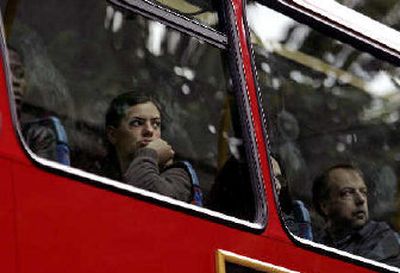Death toll rises to 49 in London

LONDON – As the death toll from a wave of bombings grew, British investigators Friday toiled to recover an unknown number of bodies and salvage physical evidence from the ruin of three subway stations and a double-decker bus targeted in coordinated attacks.
The recovery effort continued as Londoners by the thousands returned to the city center by bus and subway the morning after the worst-ever terrorist bombings in central London. By midday, the capital city was again pulsing with steady, though light, traffic, and 10 of its 12 subway lines were operating, with the exception of sections closest to the bombing sites.
Investigators said they were combing the four sites for clues to how the attacks were launched within minutes of each other, killing at least 49 people, wounding as many as 700 and, for nearly a day, paralyzing the city of 9 million.
Officials said they believed each of the devastating blasts was fueled by as little as 10 pounds of explosives.
Officials also announced that 13 people – not two as previously announced – were killed in an explosion on the bus. It remained unclear Friday how many bodies were still in the wreckage from the blasts and how many people were still missing. Officials said the death count could again climb.
Relatives of missing commuters appeared at several hospitals Friday searching for information.
Chris Agwu, a lawyer, turned up at the Royal London Hospital on Friday afternoon holding a photo of his cousin, Ojara Ikeaguru, a 55-year-old social worker who left for work on the subway Thursday and never returned. “We just need some help in finding her,” he said plaintively. “The whole family is now looking.”
Outside King’s Cross Station, where many people had been trapped in train wreckage and where bodies remained to be recovered, families taped photos of missing loved ones to a wire fence with written pleas for help. British newspapers and news broadcasts Friday recounted numerous tales of distraught family and friends still seeking confirmation of life or death.
The search for the dead and missing continued as metropolitan and transport police, in news conferences Friday, offered some insight into how the subway attacks near King’s Cross, Liverpool Street and Edgware Road occurred.
Officials said they believed that small amounts of high-level explosives were concealed in cases or backpacks. Assistant Police Commissioner Andy Hayman said officials believe the packs of bomb material were placed on the floors of the three subway cars. The small amount of explosive in each case is about half the quantity used in the Madrid bombings of 2004.
Officials were unsure what triggered a powerful explosion on a double-decker bus near Tavistock Square, authorities added, but as yet there was “absolutely nothing to suggest” a suicide bomber touched off the blast.
Metropolitan Police Commissioner Ian Blair, joining government officials in assessing the method of attack, said the bombings have “all the hallmarks of al Qaeda … but we are at the beginning of a very complex situation.”
There was no forensic evidence to tie the blasts to the radical Islamic group – a gap that government authorities acknowledged. “Most important is the forensic evidence,” Home Secretary Charles Clarke told the British Broadcasting Corp. “We are looking for a small number of evil needles in a very big haystack.”
Senior U.S. officials declined to speculate on the London bombings. On Thursday, much of the information about the fatalities was relayed to American officials.
But Secretary of State Condoleezza Rice, speaking to reporters aboard her plane on a flight to China, said, “We would be in the realm of speculation to say anything about who perpetrated the attacks or the nature of those attacks.”
British law enforcement officials emphasized repeatedly that the investigation would demand time, patience and some luck for recovery crews trying to maneuver through hot and crumpled tunnels of some of the deepest parts of the subway.
The work at King’s Cross Station was particularly tough and treacherous, said Police Commissioner Blair, who added that crews were trying to preserve evidence and free bodies in what is now a dusty, dark, subterranean crime scene.
It has been reported that 21 people died at King’s Cross, but officials were not clear Friday about how many bodies had been recovered. “We have said there are a number of bodies on that train,” Blair said, adding that the work is “very, very difficult.”
The station is on the Piccadilly line, one of the deepest on the underground, running 100 feet below the surface. The tunnel in which the train crashed also is very narrow, train officials said.
Law enforcement officials shied away from confirming reports that timers were involved in the blasts and downplayed the notion that cell phones could have been used for remote detonations. The stations were probably too deep for cell phone reception, an official said.
More details on the circumstances of the bus bombing also emerged. Bus driver George Psaradakis, 49, told reporters that he was overwhelmed by passengers after the first subway explosion but had tried to accommodate as many as he could.
“There were thousands of people coming out of the tube (subway),” he said. “There were many people who were trying to get on the bus at once. Suddenly there was a bang, then carnage.”
Psaradakis said the explosion happened behind him and he tried to help the passengers.
“There were many injured people, and at first I thought, ‘How am I alive when everyone is dying around me?’ ” Psaradakis told the British news agency Press Association.